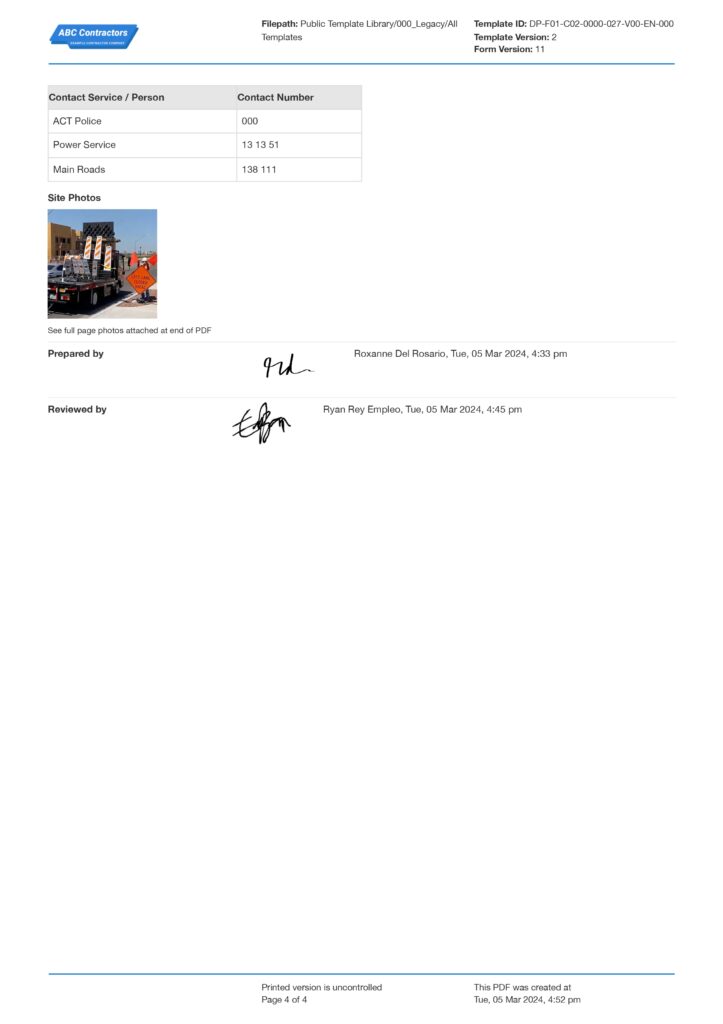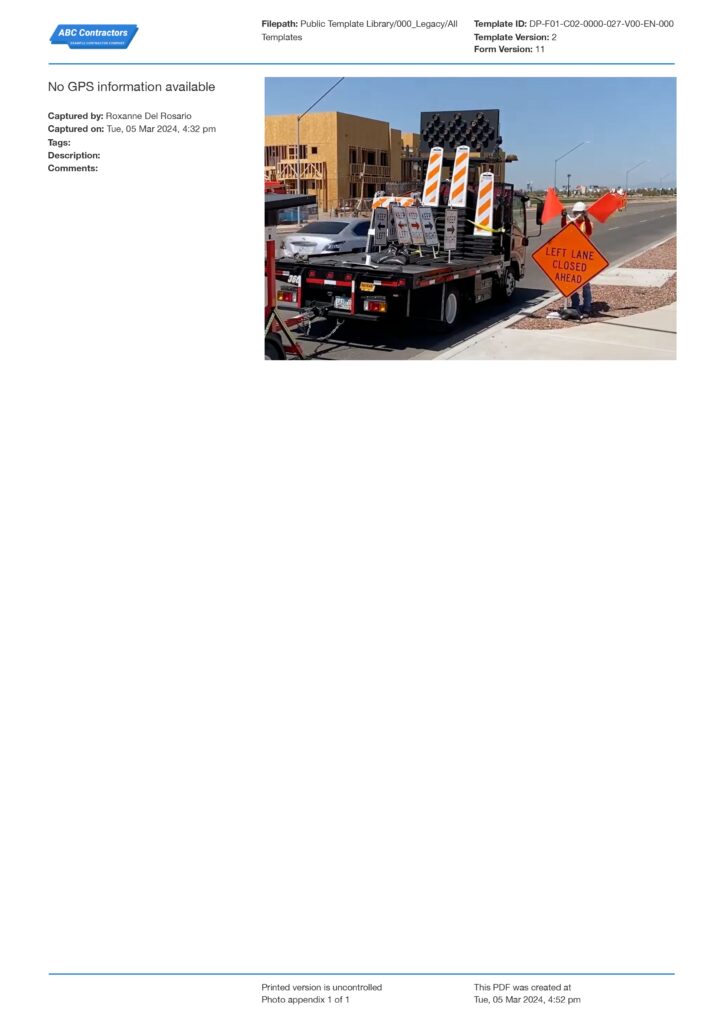Dashpivot Article – How to Make Traffic Management Plan
How to Make Traffic Management Plan
In this article, we’ll guide you through how to make a Traffic Management Plan (TMP), essential for ensuring safety, minimising disruptions, and maintaining efficient movement for vehicles, pedestrians, and cyclists.

How to Make Traffic Management Plan: Why is it Important to Know How?
Understanding how to make traffic management plans is essential for safety and operational efficiency in environments with extensive construction, maintenance, or production activities. These plans play a pivotal role in minimising accident risks and enhancing productivity by managing the movement of vehicles, machinery, and personnel effectively. In settings like commercial building projects and utilities maintenance, an effectively prepared traffic management plan can significantly reduce hazards related to vehicle and heavy equipment operations.
Traffic management plans are also required to comply with regulatory requirements. Local and state road and traffic authorities often mandate detailed traffic management strategies for project approvals, particularly when activities impact public roadways or alter traffic patterns. By knowing how to make effective traffic management plans, project managers and safety officers can ensure adherence to legal and safety standards and avoid project delays and financial penalties
How to Make Traffic Management Plan: Essential Requirements
Creating a successful traffic management plan requires a detailed and structured approach. This approach ensures the safety and efficiency of the site and guarantees compliance with regulatory standards. Here is a guide for establishing the essential framework of the traffic management plan document, with a focus on what each section in the plan must cover:
Project Details
Starting with the Project Details section is essential for any traffic management plan. This foundational segment provides an overview of the project, setting the stage for subsequent detailed planning and execution. It's vital for establishing the project's context, understanding its scope and scale, and ensuring a unified reference point for all stakeholders.
In this section, the document should include:
- Project Name: Clearly state the name of the project to distinguish it from other initiatives.
- Creator: Identify the individual or team responsible for the traffic management plan.
- Creation Date and Time: Note when the plan was finalised to understand its currency and relevance.
- Duration of Work: Specify start and end dates to frame the project's timeline.
- Location: Detail the exact site or area of operation to pinpoint the geographical context.
- Scope of Work: Describe the nature of the activities undertaken, providing insight into the complexity and scale of operations.
- Hours/Days of Work: Outline operational hours to align traffic management strategies with active work periods.
Traffic Control
Following the Project Details, the next step in creating a traffic management plan is to articulate the Traffic Control strategies. This section is pivotal in demonstrating how traffic flow, both vehicular and pedestrian, will be managed safely and efficiently within the project area. The following traffic control matters should be addressed in this section:
- Separation: This part of the plan should start by detailing how to segregate pedestrian and vehicular traffic to enhance safety. This includes establishing separate entries and exits for both, utilising physical barriers, and clearly marking exclusion zones.
- Pedestrian Routes: Next, define safe and marked pedestrian pathways that ensure unimpeded access to essential site facilities without crossing vehicle routes. The emphasis should be on the visibility and maintenance of these paths.
- Vehicle Routes: Outline the creation and maintenance of vehicle routes within the project area. This involves ensuring roads and pathways are suitable for the expected traffic volumes and types, clearly marking directions, and maintaining surfaces to prevent accidents.
- Signs: Implementing appropriate signage is crucial for directing traffic flow, indicating pedestrian zones, and highlighting potential hazards. The plan should specify the types of signs used and their placements.
- Warning Devices: Detail the use of warning devices like flashing lights and reversing alarms on powered mobile plant to alert pedestrians and other vehicles of their presence and movement, especially in areas with high traffic or limited visibility.
- Information, Training, and Supervision: Address the need for site-specific training for all personnel on traffic hazards, safe movement, and emergency procedures. This section should also cover the level of supervision required to ensure compliance with the traffic management plan.
- Personal Protective Equipment (PPE): Specify the PPE requirements, such as high-visibility clothing for individuals working near or within vehicle routes, to reduce the risk of accidents.
- Vehicles and Drivers: Conclude with guidelines for vehicle and driver management, including regular maintenance checks, safety inspections, and the reporting of faults. Highlight the importance of drivers conducting safety checks before operation and any additional control measures to manage risks.
Traffic Management Layout
After detailing the Traffic Control strategies, the next critical component in the traffic management plan is the Traffic Management Layout. This part of the plan provides a diagrammatic representation of the traffic control measures in place, including:
- Separation Zones: Clearly illustrated areas where pedestrian and vehicular traffic are segregated to prevent accidents.
- Pedestrian Routes: Marked pathways that ensure safe walking routes throughout the site, including crossings where pedestrians may intersect with vehicle paths.
- Vehicle Routes: Designated roads and lanes for different types of vehicles, ensuring smooth flow and minimising congestion. This includes entry and exit points, loading zones, and parking areas.
- Signage: Placement of signs indicating speed limits, pedestrian crossings, and directional information to guide movement and enhance safety.
- Warning Devices: Locations of warning lights, alarms, or barriers that signal potential hazards or areas requiring extra caution.
Communication and Emergency Procedure
Following the Traffic Management Layout, the plan must incorporate a comprehensive section on Communication and Emergency Procedures. This section outlines the protocols for managing various types of incidents and emergencies that may occur on-site, ensuring a swift and effective response to maintain safety.
- Traffic Incident Procedures: In the event of a traffic incident, such as a collision or an obstruction, designated personnel must assess the situation promptly. Appropriate traffic control measures will be implemented to ensure the safety of workers and road users, including directing traffic around the incident site, establishing temporary detours, or lane closures if necessary, and coordinating with emergency services as required.
- Serious Injury and Fatality: Should a serious injury or fatality occur on-site, emergency procedures will be activated immediately. Emergency services will be contacted without delay, and first aid will be administered by trained personnel until medical assistance arrives. The affected area will be cordoned off to preserve the scene for investigation, and support will be offered to affected individuals and their families.
- Failure of Services: In cases where essential services such as electricity, water, or communication systems fail, designated personnel will be notified immediately. Contingency plans will be enacted to ensure the continuity of operations, including deploying backup power sources, alternative communication channels, and temporary service provisions as necessary.
- Minor Incident or Vehicle Breakdown within Site: For minor incidents or vehicle breakdowns within the site, designated personnel will respond swiftly to assess the situation and implement measures to minimize disruptions to traffic flow and ensure the safety of workers and road users. This may involve providing roadside assistance to the affected vehicle, towing services if needed, and directing traffic around the incident site until normal operations can resume.
- Emergency Services: The plan should include a list of emergency contacts, such as ambulance services, police, fire brigade, and utility providers. This ensures that in any emergency, the site team has immediate access to the necessary contact information to respond effectively.
Site Photos
At the end of the plan, it is worthwhile having a section with some site photos. It provides visual evidence of the site conditions prior to the commencement of work, which can be invaluable for planning, risk assessment, and in the event of an incident investigation. Photos can capture key details such as existing road layouts, signage, and potential hazards.
Below is an example of a traffic management plan that follows these requirements:

Use and customise traffic management plan forms for free
Create better traffic management plans by using customisable forms
The traffic management plan above was created using a traffic management plan template. Using a standardised document for a traffic management plan ensures that all the correct information is captured in the plan. Here are some of the features that make it ideal for recording traffic managemet plans:
- Structured Sections: Clearly defined sections for Project Details, Traffic Control, Traffic Management Layout, and Communication and Emergency Procedures ensure comprehensive coverage of all critical aspects.
- Checklist Format: Utilises a checklist approach within each section to ensure no important detail is overlooked, facilitating thorough preparation and review.
- Predefined Categories: Includes predefined categories for incidents, PPE, vehicle management, etc., streamlining the process of detailing specific protocols and requirements.
- Space for Diagrams: Allocates space for traffic management layout diagrams, allowing for visual representation of plans which complements the textual descriptions.
- Emergency Contact List: Dedicated section for emergency contacts, ensuring quick access to essential services, enhancing response efficiency in critical situations.
- Photo Appendices: Provision for attaching site photos, offering a visual baseline of site conditions and facilitating better understanding and planning.
Further improve your traffic management plans with digital solutions
Using standardised forms to record traffic management plans gives them structure and ensures that the correct information is captured each time. However, keeping individual plans for multiple work sites still presents problems at an organisational level.
Any changes made to the plan require a new version to be created and then deployed at the site. Access to the plan on-site is typically limited, so more senior staff will have to direct team supervisors on changes and then the supervisors will have to inform their teams.
More generally, traffic management plans are difficult to refer to during day-to-day operations. This prevents them from being referenced to when they are needed for clarification, which can lead to safety incidents.
This is why many companies now use a traffic management plan app to manage all their safety plans. An application allows for all traffic management plans to be digitally created, completed, managed, and accessed at any time from a desktop, tablet or mobile.
This allows for new plans to be deployed instantaneously and for workers to be notified of changes in real time. Team members at all levels can have access to the plan on their mobile devices, allowing them to refer to vital safety information when required.

Traffic Control Plan template
Create and complete reliable traffic control plans to keep all of your stakeholders and equipment moving around site safely.

Safe Work Method Statement for Mobile Plant template
Reduce mobile plant incidents and ensure everyone working on and around mobile plant is doing it safely.

Safe Work Method Statement for Driving/Transportation template
Ensure your workers and projects are referencing a good safe work method statement when driving - not bad habits.





